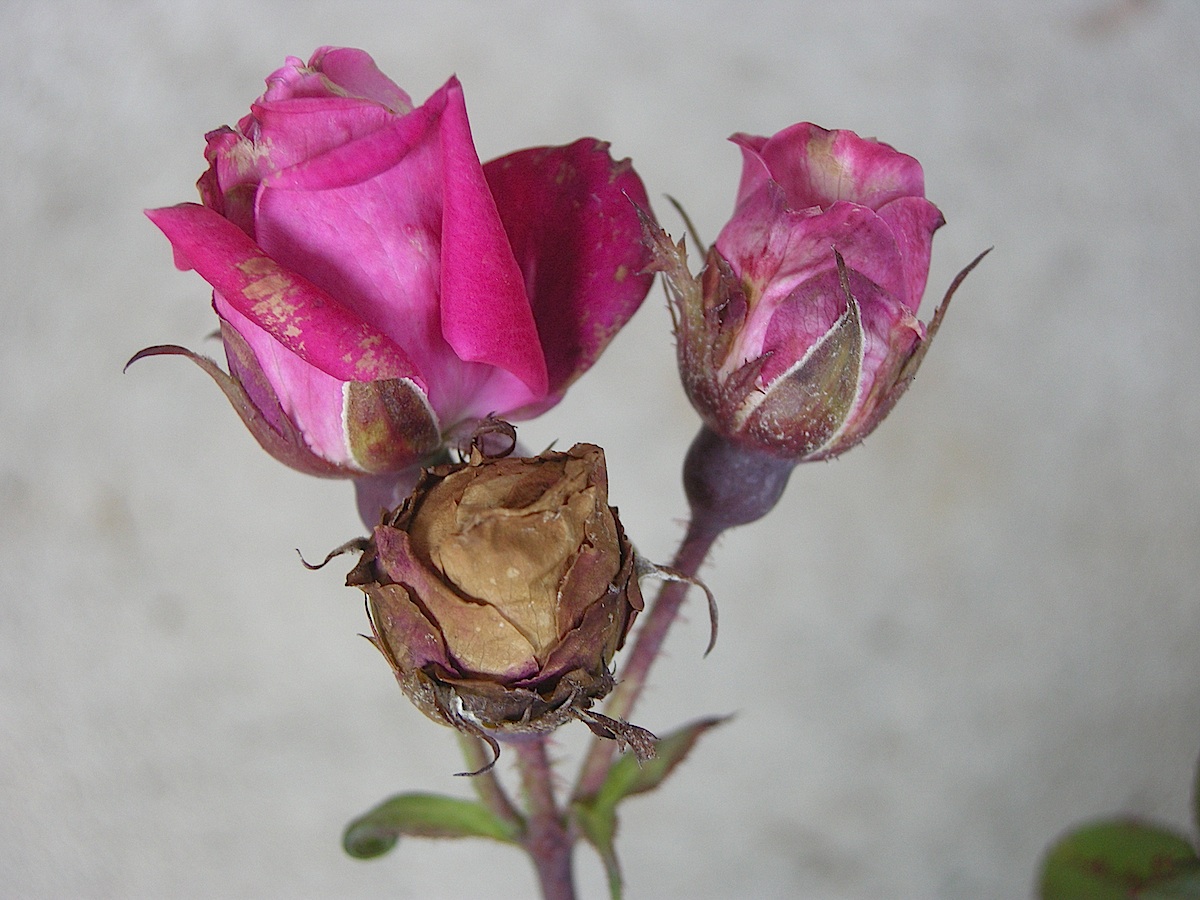
Rose Downy Mildew Review
During the past 20 years, rose downy mildew has become a serious problem, causing significant losses to growers almost every year. The disease has been found in nearly every state across the United States (and Canadian provinces). It does not occur each year since conditions that promote it are not always present. Various downy mildew diseases can occur on many plants (including roses) in the nursery or landscape, but not all of these are caused by the same pathogen. The downy mildews on most vegetables and flowers are distinct they do not cross from one plant to another as a general rule, unless the disease hosts are from the same plant family. The cause of rose downy mildew is Peronospora sparsa, which also attacks certain cane berries (blackberry and raspberry) and all types of roses, both wild and cultivated.
Although it may seem that your bare-root roses come with downy mildew, they may be infected from other sources. Roses in landscapes or natural areas around your production site, as well as crop material left over from previous seasons, are likely sources of a downy mildew outbreak. The spores can live in these roses in a dormant state only to become active when the cool, wet weather of late winter and early spring occurs. Be sure to check last year’s roses carefully for signs of downy mildew just as often as you check those in this year’s production. If you are not checking frequently, your first indication of trouble may be extensive leaf drop!
Symptoms
Rose downy mildew is remarkably variable. In the past 20 years the most common symptom has been angular, tan spots with a very small amount of white crystalline sporulation on leaf undersides. The name of the pathogen Peronospora sparsa reflects the sparse production of white spores. Sometimes collapsing buds or cankers form on newly emerging rose canes. Different species and cultivars of roses respond differently to downy mildew, making a diagnosis very difficult. Severe leaf drop is common on some cultivars. Tiny speckles may form that are tan or even bright pink. Such symptoms are difficult to distinguish from early infections with Botrytis, powdery mildew or even rust. Under moist conditions, leaves turn brownish or yellow and drop. A white, downy fungus growth may occur on leaf undersides, but this is usually too hard to see without a microscope. Under drier conditions, leaf spots appear as brown burned areas, mimicking spray injury. Reddish streaks or sunken cankers can also occur on rose canes. Since similar cankers can be caused by other pathogens like Botrytis and Coniothyrium, it is a good idea to have canker symptoms diagnosed by a university or private lab. Sometimes downy mildew sporulation can be observed directly on discolored spots on canes if they are first incubated at a high humidity for a few days.
Cultural Control
Symptoms can appear almost overnight and a severe outbreak can take off if you do not act preventively. Fans and wind easily move spores from plant to plant but are your best allies in preventing downy mildew outbreaks, since they improve air circulation around plants, dry leaves rapidly and reduce relative humidity. Downy mildew weather is cool to warm, humid and rainy. Wet leaves and high humidity will trigger sporulation overnight. When the sun comes up, leaves start to dry and spores are released. Most spores spread by fans or wind and infect new leaves before noon. Six hours of constant leaf wetness are enough for spores of many downy mildew fungi to germinate and infect leaves. Even though fans might move spores, you should use them along with venting to reduce humidity and leaf wetness. Try to water early in the day or whenever leaves will dry quickly, to ensure dry foliage at night. Check all new plants for symptoms upon receipt. Early detection is the only way to control downy mildew. Scout all plants at least once a week, preferably every two to three days. Remember: hungry plants are more susceptible to downy mildew. Maintain a balanced fertility program to protect your crops.
The cultural steps that should be taken when growing garden roses are:
1. Destroy rose debris from previous crops spores can overwinter in leaves and canes, then the downy mildew can attack new plants.
2. To protect them from infection, isolate new shipments away from last year’s plants.
3. Space plants to allow rapid drying of leaves. If the leaves are touching, they are too close. As the canopy closes in, the humidity increases.
4. Water at a time of day that will promote the fastest possible drying.
5. Apply fungicides preventively.
Fungicides for Control
Choosing the most effective fungicides to prevent or eradicate rose downy mildew can be tough. Although plant pathologists usually like to lump a lot of trials on a single type of pathogen together, we sometimes find that specific results occur on specific crops. This has been the case with rose in our experience. Start early with a rotation of chemicals for prevention.
Chase Horticultural Research, Inc. performed a trial on greenhouse potted roses in 2004. The roses were infected prior to spraying twice on a 10-day interval. Results showed that in an eradication scenario, the strobilurins were not effective on rose downy mildew. You can see from Table 1 that Heritage and Insignia were not effective used at very low rates. Cygnus (no longer available) and Compass O were more effective (also used at very low rates) but were still not significantly better than the water-sprayed controls. This is not an unusual result for rose downy mildew based on reviewing all of the trials that have been published or otherwise made available. Using even the highest labeled rates of the strobilurins is rarely as effective on roses as it is on nearly all other plants affected by downy mildew fungi.
In the same trial, excellent control was seen with Segway (all rates tested), Stature DM, Aliette and Subdue MAXX (used as a foliar spray in this case). Be sure to tank-mix Subdue MAXX with another product for downy mildew control if you are going to spray the product (as per label directions). Remember that the 0 REI is for drenching Subdue MAXX and use as a foliar spray for downy mildew requires a 48 hour REI. Do not use more than 2 oz/100 gal of Aliette, as higher rates have been shown to reduce downy mildew control on some plants.
Over the past 15 years about 15 trials have been performed (and reported) for control of rose downy mildew from Florida to Alabama to California in the greenhouse and in the field. They are summarized in Table 2.
The most consistently effective products for downy mildew on rose have been Subdue MAXX (1 to 2 oz/100 gal) used as a foliar spray, Micora (8 oz/100 gal), Stature SC (12.25 oz/100 gal), Aliette (2.5 oz/100 gal) and Segway (3.5 oz/100 gal). Remember to follow labels carefully. Subdue MAXX and Adorn must be tank-mixed with another product from a different MOA group that is effective on downy mildew (they can be mixed with each other, for example). You cannot rotate products with the same MOA group number. That means products in MOA group 40 (Stature, Micora and Orvego), although really effective, cannot be rotated with one another. Similarly, if you decide to use a strobilurin (or FenStop), these materials all belong to MOA 11 and rotation dictates using something from another MOA group.
Another fact that appeared in reviewing the available trials was that a shorter interval is usually more effective. Thus, using a fungicide once a week is better than using one once a month. Using one every 10 days is better than every 14 days. However, for a spray program to be effective you must remember to apply it. If a 10-day interval is hard to implement, you should switch to every seven days (curative) or 14 days (preventative). Weekly spraying to prevent downy mildew on sensitive crops is common at times of year when environmental conditions favor disease. Spraying more often may be counter productive.
A final word make sure you are treating the right disease. It is surprising how many times roses are being sprayed for black spot when they really have downy mildew. Get a diagnosis!


 Video Library
Video Library 



















